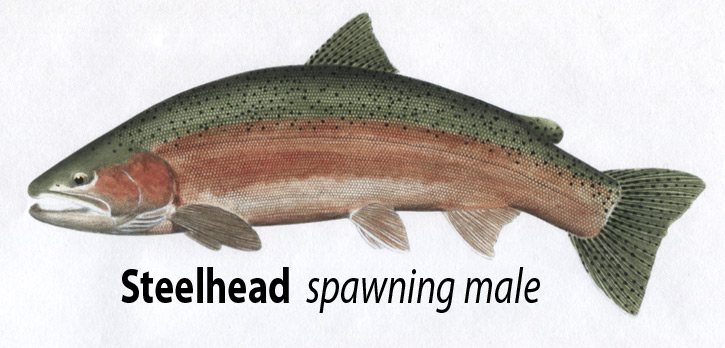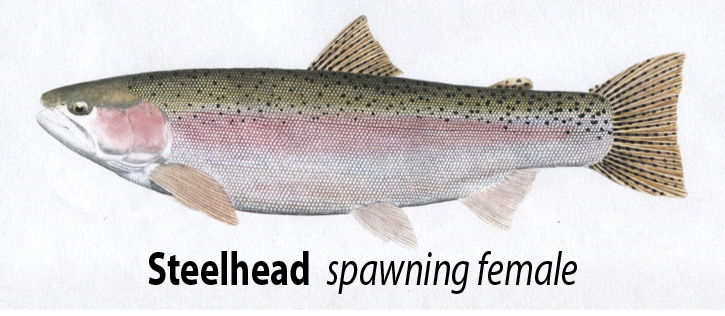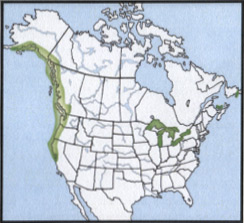Steelhead, March 2012, Fish of the Month!


 Steelhead
Steelhead
Oncorhynchus mykiss
Local Names:
Steelie, Steelhead trout, Coast Rainbow trout, Silver trout
Average Size:
18 to 32 inches
2 to 12 pounds
Distinguishing Field Marks:
Color and color pattern are reliable distinguishing field marks for this species. (See the illustration.)
-
Steelhead bodies tend to be more elongated than those of non-migratory Rainbow trout.
-
The back, tail, adipose, and dorsal fins are lightly sprinkled with small black spots.
-
Both the upper and lower lobes of the tail fin are spotted, distinguishing Steelhead from Coho salmon
-
The caudal peduncle is thick, making it difficult to lift a Steelhead by the base of its tail..

-
There are 8 to 12 principle rays in the anal fin.
-
The side and belly of fresh-run Steelhead are bright silvery white. Their backs range in color from pale to dark olive green or steely slate gray.
-
As Steelhead progress up-stream to their spawning grounds, they gradually assume the colors of non-migratory Rainbow trout, while maintaining their longer body shape.
North American Range:
Map to the right shows approximate range in North America.
Diet:
In streams, Steelhead fry feed on small planktonic organisms that drift to them on the stream's current. As parr, they feed mainly on immature aquatic insects and a broad range of other invertebrates, as available. In their natal streams Steelhead are opportunistic and take whatever foods come their way, relying heavily on aquatic insects and other aquatic invertebrates.
At sea, Steelhead feed on shrimps, squid, and smaller fishes, as they encounter them. In lakes they feed on aquatic invertebrates and fishes. In the Great Lakes, Steelhead are less dependent than Chinook or Coho salmon on Alewife for food. Their Great Lakes diet consists of the larger aquatic invertebrates, and a large percentage of a variety of small forage fish, such as Emerald shiners, and, more recently, the exotic Round goby. Unlike the salmons, Steelhead do actively feed when on their spawning runs. Where salmon are present, Steelhead runs are often triggered by their cousins' runs, during which the trout feed heavily on salmon eggs. After the salmon runs subside, Steelhead turn their attention to immature aquatic insects, subsisting on these until they spawn in late winter or early spring.
Fly Fishing for Steelhead:
Yes folks, the Steelhead is, as you probably already know, one of the fly fishing world's most actively sought species. They have all the attributes of prime game fish: an aggressive nature that can lead to their very actively taking artificail flies, as well as lures and baits; rugged power and stamina that make them challenging for even veteran anglers; and a willingness to make acrobatic leaps of all sorts and from any and all take-off points.
Why certain populations of Rainbow trout migrate to sea or lake, while others in the same stream do not, no one knows, but they do. After three to four years growing in the streams of their birth, Steelhead come to the stage in their lives known as smolt. At this time their coloful spotted bodies turn a bright silver and they head downstream. Once at sea, or in large lakes, they grow rapidly on a larger variety of food than is offered by the streams. On average, after one to three years "at sea," Steelhead return to the streams where they were born to spawn. It is these runs that afford the fly fisher his or her best opportunities to hook a Steelhead. The majority of Steelhead runs take place in the fall of the year.
Like all anadromous salmon and trout, Steelhead runs, especially in their native North American West coast ranges, have been significantly reduced during the last 50 years. Many "classic" Steelhead rivers historically hosted runs nearly every month of the year, as was true for Chinook and Coho salmon as well. As a result of habitat loss, river de-watering, and over-harvesting, many of these once huge runs have all but disappeared. The Great Lakes, because of their relatively insulated natures have fared somewhat better. But, in both their native range and in the Great Lakes, Steelhead runs vary widely in numbers from year to year.
As is the case with most of our favorite trout species, flies for Steelhead come in a staggering variety of patterns, with new ones being continually developed. There are many excellent books of Steelhead fly patterns presenty available. My favorite is Flies for Steelhead by Dick Stewart and Farrow Allen. No longer in print, the book has gotten to be a little "pricy" but, is well worth it. Wherever you seek fly reference, you're going to find dries, traditional wets, nymphs, and egg immitating patterns. As always, contacting tackle shops and guide services local to your chosen Steelhead stream is highly recommended.
Now, you've decided you're going to throw some flies at these amazing trout? O.K., on the large West Coast Steelhead rivers you'll be covering a lot of water with each cast, so longer rods, say 10 to 12 feet will help you get the 8 to 9 weight line out. On some rivers Steelhead will reward the persistent fly-caster by hitting a dry fly. Unfortunately, this is not typical. Most Steelheading requires the angler's getting the fly down to the fish. Full sinking lines in those larger weights are no longer the coin of the realm, having been recently replaced by sinking tips on floating lines. Again, the range of possibilites is quite broad. My rig of choice now is a 5 or 10 foot (depending on water levels) extra fast sinking leader, loop attached to my 8 weight floating fly line with a short (18 to 24 inch) section of 6 or 8 pound test flourocarbon between the leader and fly. Here, on the east shore of Lake Ontario, many fly rodders are Spey fishing flies under strike indicators. Personally, I've found (a bit of Hook & Hackle product promotion here) a Batson/H&H 10' 8" 8 weight 4 piece "switch rod" with a fast-sinking 5' leader on an 8 wght floating line to be my go-to outfit. I find that strike indicators at the business end of an 8 weight line require too much heavy lifting to free the belly of the line from the water's surface at the instant the indicator/float telegraphs a possible take. Again, on the larger West Coast rivers, you'll probalby want a more powerful outfit than this.
I know Spey casting is all the rage now, but, having been to that movie some 20 years ago, I've settled on "switch" rods as the perfect median. They're capable of covering plenty of water, but not so much that you're hooking fish too far from you to control, and they're short enough to very comfortably fish close in. Plus "switch" rods are so named because they can be cast with either one or two hands; the best of both worlds.
Do not try to save pennies by assuming that your five weight single action click and pawl trout reel can double as your Steelhead reel. If it's your favorite "trout reel?" leave it at home. Hook a ten pound Steelhead on it and you may well have the fun of literally watching it burn up as the fish freight-trains ints first runs away from you. Invest in reels that have plenty of backing capacity in the six to nine weight class. A good, smooth drag in whatever reel you choose is a necessity….Happily for us, the range of species specific fly-reel possibilities has grown exponetially in the last 50 or so years. As always, base your equipment choices on the size of the waters you plan to fish.
O.K., you've got your rod, reel, line, leaders, waders, flies, water bottle, (flask), rain gear (to insure that it won't rain that day), fingerless gloves, etc., etc., etc……..and the river Goddess has smiled on you and told a bright 11 pound Steelhead to aggressively strike that #8 Green Butt Skunk you've drifted by the fish at least 50 times……Hang on!!!!! You've just hooked a fish that I often describe to Steelheading wanna be's as "psychotic." When asked, "How'd you do today?" I've heard many Steelhead guides reply, "Well, we got beat up by four fish today." "Any to hand?" "Nope." I remember hooking a Steelhead many years ago now that jumped 3 times before I could even get my rod-to-fish connection tightened, tightened just in time for the line to go slack with a thrown fly at its end. Another fish I hooked in the middle of a large pool made a powerful straight-line run away from me into an apron of the pool-bottom that was covered by only about 18 inches of water……Ooooooopppps, in a heart-beat that 9 or so pound fish had made a 180 degree turn and was headed straight back to me at warp speed…..So, my friend, how fast can you reel up that slack to once again make contact with your so recently hooked prize?
Folks, "A great game fish is too valuable to use only once." A Steelhead is truly a great game fish. You want fish for you and your kids and your kids' kids to enjoy as you do? Put 'em back alive. Don't fish in conditions that are either so warm or so cold that the fish are stressed just trying to maintain. If you take a Steelhead you've caught out of the water into 10 degree F. air, it's eyes will very quickly freeze….
As always, carefully read and understand all state, provincial, and local regulations before you cast your flies to any game fish, anywhere, in any season. These are our fish, in other words, they belong to all of us, not just those of us who're expert at catching them. It's up to all of us, working in support of our regional fisheries managers, to sustain and, we can hope, grow our invaluable sport fishing heritage.






